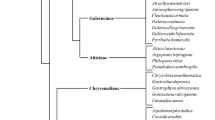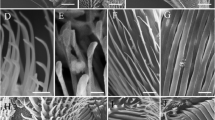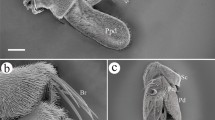Abstract
Adult foretarsi of Heliconius erato Linnaeus (Lepidoptera, Nymphalidae) are reduced in size and are not used for walking. Foretarsi of the female have specialized sensilla that are presumably used to identify the host plant, by drumming. The mid- and hind tarsi also bear sensilla in both sexes, but these have not been described in detail, nor has their chemosensory function been determined. We described and compared the tarsi of H. erato under light and scanning electron microscopy. Behavioral experiments showed that differences in the shape, number, and size of sensilla were related to feeding and oviposition behaviors. Two types of sensillum (chaeticum and trichodeum) were found in similar numbers and size on the mid- and hind tarsi of both sexes. Sensilla on the female foretarsi act in host-plant site selection, strongly affecting oviposition rates when isolated. Male foretarsi lack sensilla, which may have been selected against due to the absence of function and thus lost. Sensilla on the mid- and hind tarsi are involved in sugar detection in both sexes, responding to an effective dose of sucrose (ED50) near 0.01 M, and therefore might be used to identify food resources when the butterflies settle on flowers.







Similar content being viewed by others
References
Al Bitar L, Voight D, Zebitz CPW, Gorb SN (2009) Tarsal morphology and attachment ability of the codling moth Cydia pomonella L. (Lepidoptera, Tortricidae) to smooth surfaces. J Insect Physiol 44:1029–1038
Baker HB, Baker I (1983) A brief historical review of the chemistry of floral nectar. In: Bentley B, Elias T (eds) The biology of nectaries. Columbia University Press, New York, pp 126–152
Barp EA, Soares GLG, Giani EJM, Rodrigues D, Moreira GRP (2011) Variation in nectar and pollen availability, sucrose preference, and daily response in the use of flowers by Heliconius erato phyllis. J Insect Behav 24:200–219
Benson WW (1978) Resource partitioning in passion vine butterflies. Evolution 32:493–518
Benson WW, Brown KS, Gilbert LE (1976) Coevolution of plants and herbivores: passion flower butterflies. Evolution 29:659–680
Birk CD, Provensi G, Gosmann G (2005) TLC fingerprint of flavonoids and saponins from Passiflora species. J Liq Chrom Rel Technol 28:2285–2291
Briscoe AD, Macias-Muñoz A, Kozak KM, Walters JR, Yuan F, Jamie GA, Martin SH, Dasmahapatra KK, Ferguson LC, Mallet J, Jacquin-Joly E, Jiggins CD (2013) Female behaviour drives expression and evolution of gustatory receptors in butterflies. PLoS Genet 9:e1003620. doi:10.1371/journal.pgen.1003620
Brown KS (1979) Ecologia geográfica e evolução nas florestas neotropicais, vol 1. Universidade Estadual de Campinas, Campinas
Brown KS, Mielke OHH (1972) The heliconians of Brazil (Lepidoptera: Nymphalidae). Part II. Introduction and general comments, with a supplementary revision of the tribe. Zoologica 57:1–40
Calvert WH (1974) The external morphology of foretarsal receptors involved with host discrimination by the nymphalid butterfly, Chlosyne lacinia. Ann Entomol Soc Am 67:853–856
Corrêa CA, Irgang BE, Moreira GRP (2001) Estrutura floral das angiospermas usadas por Heliconius erato phyllis (Lepidoptera, Nymphalidae) no Rio Grande do Sul, Brasil. Iheringia, Ser Zool 90:71–84
Crane J (1955) Imaginal behavior of a Trinidad butterfly, Heliconius erato hydara Hewitson, with special reference to the social use of color. Zoologica 40:167–195
Emsley MG (1963) A morphological study of imagine Heliconiinae (Lep.: Nymphalidae) with a consideration of the evolutionary relationships within the group. Zoologica 48:85–130
Faucheux MJ (2013) Sensillum types on the proboscis of the Lepidoptera: a review. Ann Soc Ent Fr 49:73–90
Feeney P, Rosenberry L, Carter M (1983) Chemical aspects of oviposition behavior in butterflies. In: Ahmad S (ed) Herbivorous insects: host-seeking behavior and mechanisms. Academic Press, New York, pp 27–75
Ferro VG (1998) Criação de Heliconius erato phyllis (Fabricius) (Lepidoptera: Nymphalidae) em condições semi-naturais. Unpublished Honors Thesis, Zoology Department, UFRGS, Porto Alegre, 49p
Finney DJ (ed) (1952) Probit analysis. Cambridge University Press, Cambridge
Fox RM (1966) Forelegs of butterflies I. Introduction: chemoreception. J Res Lepid 5:1–12
Gershenzon J, Croteau R (1991) Terpenoids. In: Rosenthal GA, Berenbaum MR (eds) Herbivores: their interactions with secondary plant metabolites, vol 1, 2nd edn. Academic Press, San Diego, pp 165–219
Gilbert LE (1972) Pollen feeding and reproductive biology of Heliconius butterflies. Proc Natl Acad Sci U S A 69:1403–1407
Gilbert LE (1991) Biodiversity of a central American Heliconius community: pattern, process, and problems. In: Price PW, Lewinsohn TL, Fernandes GW, Benson WW (eds) Plant-animal interactions: evolutionary ecology in tropical and temperate regions. John Wiley & Sons, New York, pp 403–427
Hartmann T (1991) Alkaloids. In: Rosenthal GA, Berenbaum MR (eds) Herbivores: their interactions with secondary plant metabolites, 2nd ed, vol 1. Academic Press, San Diego, pp 79–121
Hikl A-L, Krenn HW (2011) Pollen processing behavior of Heliconius butterflies: a derived grooming behavior. J Insect Sci 11:99. doi: 10.1673/031.011.9901
Inoue TA, Asaoka K, Seta K, Imaeda D, Ozaki M (2009) Sugar receptor response of the food-canal taste sensilla in a nectar-feeding swallowtail butterfly, Papilio xuthus. Naturwissenschaften 96:355–363
Kerpel SM, Moreira GRP (2005) Absence of learning and local specialization on host plant selection by Heliconius erato. J Insect Behav 18:433–452
Kerpel SM, Soprano E, Moreira GRP (2006) Effect of nitrogen on Passiflora suberosa L. (Passifloraceae) and consequences for larval performance and oviposition in Heliconius erato phyllis (Fabricius) (Lepidoptera, Nymphalidae). Neotrop Entomol 35:192–200
Krenn HW, Penz CM (1998) Mouthparts of Heliconius butterflies (Lepidoptera: Nymphalidae): a search for anatomical adaptations to pollen-feeding behavior. Int J Insect Morphol Embryol 27:301–309
Loon JJA (1996) Chemosensory basis of feeding and oviposition behavior in herbivorous insects: a glance at the periphery. Ent Exp Appl 80:7–13
Menna-Barreto Y, Araújo AM (1985) Evidence for host plant preference in Heliconius erato phyllis from southern Brazil (Nymphalidae). J Res Lepid 24:41–46
Moreira GRP, Silva DS, Gonçalves GL (2017) Comparative morphology of the prothoracic leg in heliconian butterflies: Tracing size allometry, podite fusions and losses in ontogeny and phylogeny. Arthropod Struct Dev (submitted)
Mugrabi-Oliveira E, Moreira GRP (1996) Conspecific mimics and low host plant availability reduce egg laying by Heliconius erato phyllis (Lepidoptera: Nymphalidae). Revta Bras Zool 13:929–937
Nagy BAL (1978) An improved rapid method that demonstrates cuticular topography, including sensilla, in arthropods. Proc Entomol Soc Ontario 109:75–81
Nayak SV, Singh N (1983) Sensilla on the tarsal segments and mouthparts of adult Drosophila melanogaster Meigen (Diptera: Drosophilidae). Int J Insect Morphol Embryol 12:273–291
Ozaki K, Ryuda M, Yamada A, Utoguchi A, Ishimoto H, Calas D, Marion-Poll F, Tanimura T, Yoshikawa H (2011) A gustatory receptor involved in host plant recognition for oviposition of a swallowtail butterfly. Nat Commun 2:542. doi:10.1038/ncomms1548|www.nature.com/naturecommunications
Périco E, Araújo AM (1991) Suitability of host plants (Passifloraceae) and their acceptableness by Heliconius erato and Dryas iulia (Lepidoptera: Nymphalidae). Evol Biol 5:59–74
Ramaswamy SB (1987) Behavioural responses to Heliothis virescens (Lepidoptera: Noctuidae) to stimulation with sugars. J Insect Physiol 33:755–760
Ramaswamy SB (1988) Host finding by moths: sensory modalities and behaviours. J Insect Physiol 34:235–249
Renou M (1983) Les récepteurs gustatifs du tarse antérieur de la femelle d'Heliconius charitounius (Lep.: Heliconiidae). Annls Soc Ent Fr (NS) 19:101–106
Rodrigues D, Moreira GRP (2002) Geographical variation in larval host-plant use by Heliconius erato (Lepidoptera: Nymphalidae) and consequences for adult life history. Braz J Biol 62:321–332
Ryuda M, Calas-List D, Yamada A, Marion-Poll F, Yoshikawa H, Tanimura T, Ozaki K (2013) Gustatory sensing mechanism coding for multiple oviposition stimulants in the swallowtail butterfly, Papilio xuthus. J Neurosci 33:914–924
Silva DS (2015) Descrição, função e evolução dos tarsos protorácicos em heliconíneos (Lepidoptera, Nymphalidae). Unpublished Ph.D. Dissertation. Programa de Pós-Graduação em Biologia Animal, Universidade Federal do Rio Grande do Sul, Porto Alegre. 88p
Silva AK, Gonçalves GL, Moreira GRP (2014) Larval feeding choices in heliconians: induced preferences are not constrained by performance and host plant phylogeny. Anim Behav 89:155–162
Swihart SL (1971) Colour discrimination by the butterfly Heliconius charitonius Linn. Anim Behav 19:156–164
Thiele SC, Rodrigues D, Moreira GRP (2016) Oviposition in Heliconius erato (Lepidoptera, Nymphalidae): how essential is drumming behavior for host-plant selection? J Insect Behav 29:283. doi:10.1007/s10905-016-9559-z
Wolfe JM, Oliver JC, Monteiro A (2011) Evolutionary reduction of the first thoracic limb in butterflies. J Insect Sci 11:66. Available online: www.insectscience.org/11.66
Zacharuck RY (1985) Antennae and sensilla. In: Kerkut GA, Gilbert LI (eds) Comprehensive insect physiology, biochemistry and pharmacology, vol 6. Pergamon Press, Oxford, pp 1–69
Zar JH (1999) Biostatistical analysis, 4th edn. Prentice Hall, Upper Saddle River
Acknowledgments
We are especially grateful to Maeve Godoy and Clarissa Azevedo (UFRGS) for their assistance with field experiments, and to Luiz A. Campos (UFRGS) for suggestions that improved the first draft of the manuscript. Thanks are also due to Janet W. Reid for editing the text. Financial support for this research came in part from a CAPES Doctoral Fellowship granted to D. S. Silva. G. R. P. Moreira was supported by a CNPq grant (309853/2014-1).
Author information
Authors and Affiliations
Corresponding author
Additional information
Edited by André VL Freitas – UNICAMP
Rights and permissions
About this article
Cite this article
Silva, D.S., Barp, E.A., Kucharski, L.C.R. et al. Sensing the Plant Surface Prior to Feeding and Oviposition: Differences in External Ultrastructure and Function Among Tarsi of Heliconius erato . Neotrop Entomol 47, 85–95 (2018). https://doi.org/10.1007/s13744-017-0508-0
Received:
Accepted:
Published:
Issue Date:
DOI: https://doi.org/10.1007/s13744-017-0508-0




